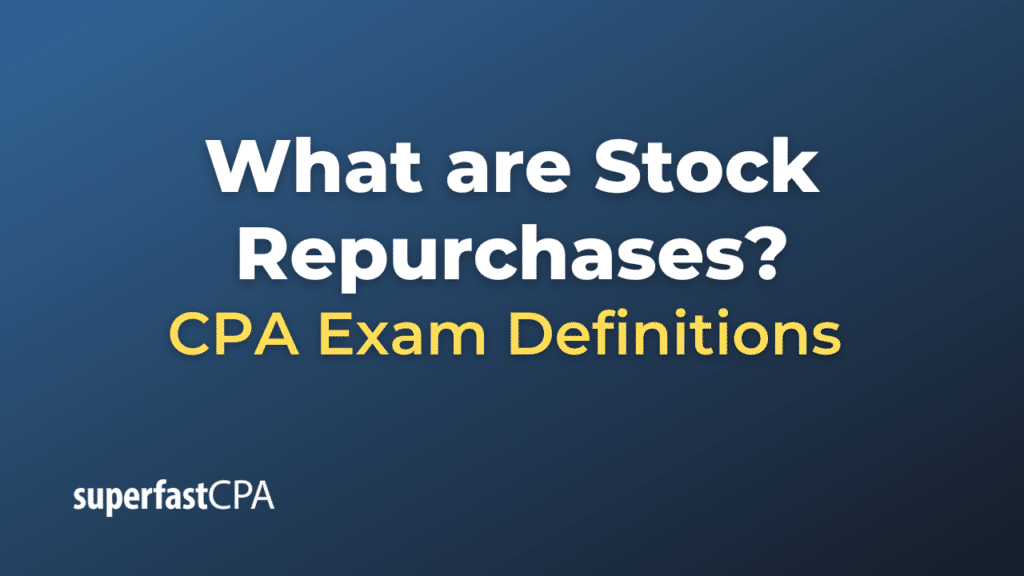Stock Repurchases
Stock repurchases, often referred to as share buybacks, occur when a company buys back its own shares from the open market or directly from shareholders. There are several reasons why a company might decide to repurchase its own shares:
- Return Excess Cash to Shareholders: If a company has accumulated more cash than it needs for its operations, investments, or other expenditures, it might decide to return some of that cash to its shareholders by buying back shares. This is an alternative to distributing cash via dividends.
- Earnings Per Share (EPS) Boost : By reducing the number of shares outstanding, a company can increase its EPS, all else being equal. This can make the company appear more attractive to investors.
- Stock Price Support or Boost : Companies might believe that their stock is undervalued. By buying back shares, they can provide upward pressure on the stock price. This not only sends a signal to the market about management’s confidence in the company’s prospects but also directly supports the stock price.
- Offset Dilution: Companies often issue new shares to employees as part of compensation packages (e.g., stock options). By repurchasing shares, companies can offset this dilution and reduce the total number of shares outstanding.
- Capital Structure Alteration: Companies might buy back shares as a means to change their capital structure. For instance, if a company feels that it has too much equity relative to debt, it might finance a share buyback with debt to change its leverage ratios.
- Flexibility: Unlike dividends, which are often expected to be regular and sometimes even increasing over time, share repurchases can be more sporadic. This provides companies with flexibility in deciding when and how much cash to return to shareholders.
However, not everyone views stock repurchases positively:
- Critics argue that companies sometimes buy back shares to artificially inflate financial metrics rather than investing in growth or paying workers more.
- Others believe that excessive buybacks can lead to increased volatility or that companies might repurchase shares at inopportune times (e.g., when shares are overvalued).
It’s essential for investors and stakeholders to understand the motivations behind any share repurchase program and consider it within the broader context of the company’s financial health and strategy.
Example of Stock Repurchases
Let’s walk through a simplified hypothetical example to illustrate the concept of stock repurchases:
Company A:
- Current Number of Shares Outstanding: 1,000,000
- Earnings (Net Income): $2,000,000
- Current Earnings Per Share (EPS): $2.00 ($2,000,000 ÷ 1,000,000)
- Current Stock Price: $50
Now, let’s say Company A decides that its stock is undervalued and it has excess cash on its balance sheet. It decides to repurchase 100,000 of its own shares at the current stock price, costing the company $5,000,000 ($50 x 100,000).
Post repurchase:
- Number of Shares Outstanding: 900,000 (1,000,000 – 100,000)
- Earnings (Net Income) remains the same: $2,000,000
- New Earnings Per Share (EPS): $2.22 ($2,000,000 ÷ 900,000)
Observations:
- EPS Boost: As you can see, by reducing the number of shares outstanding, the EPS has increased from $2.00 to $2.22, even though the actual net income remains the same.
- Potential Stock Price Support: If the market values the company at the same price-to-earnings (P/E) ratio, the stock price might also increase. If the previous P/E was 25 (given by $50 ÷ $2.00), and it remains constant, the new stock price would be $55.50 ($2.22 x 25).
- Return of Capital to Shareholders: The company used $5,000,000 of its cash to buy back the shares, effectively returning that capital to the shareholders who sold their shares.
- Signaling: The act of repurchasing might send a signal to the market that the company believes its stock is undervalued, which can positively affect investor sentiment.
- Reduction in Equity: On the company’s balance sheet, the equity portion will reduce by the amount spent on the repurchase, reflecting the return of capital to shareholders.
In the real world, numerous other factors might influence the company’s decision and the market’s reaction. Still, this simplified example demonstrates the basic mechanics and immediate effects of a share buyback.













